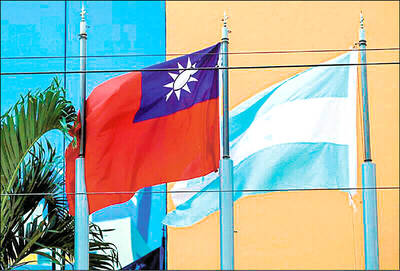Activists painted a gloomy picture of the future of the country’s agricultural sector and urged government officials and lawmakers to reconsider a bill that would lead to conversion of large portions of farmland to other purposes under the pretense of “rural renewal.”
The government’s plan to revitalize farming villages nationwide was one of the “i-Taiwan 12 projects” in President Ma Ying-jeou’s (馬英九) election platform. Approved by the Cabinet in October, the bill zipped through the legislature’s Economics Committee in December after only three sessions, with lawmakers brooking no delay to increase the proposed budget of NT$150 billion (US$4.44 billion) to NT$200 billion over a period of 10 years.
Growing opposition to the bill and warnings of the dangers that it represents have kept the bill in the legislature, which would otherwise have been enacted earlier this year.
Opposition has been driven by the reality that people do not want to say goodbye to farms.
Architect Sun Te-hung (孫德鴻), designer of the Shihsanhang Museum of Archeology — which won the coveted Eastern Architectural Design Award in 2003 — said the bill reflected a longstanding view within government that agriculture is “of no value.”
“Look at the laws and regulations regarding rural villages enacted in recent years. Next to none were about farm estate development … which resulted in great amounts of land suited for agriculture being converted into building zones,” Sun said. “If the bill is passed, farmland is set to shrink further.”
The Food and Fertilizer Technology Center for the Asian and Pacific Region said Taiwan’s self-sufficiency rate of major grain products was 23 percent in 2005, lower than the 28 percent seen in Japan and 29.4 percent in South Korea and far below the 95 percent in China and 128 percent seen in the US and many European countries.
Between 1997 and 2007, Taiwan saw a dramatic loss of arable land — about 32,000 hectares — accounting for nearly 4 percent of the country’s cultivated land.
Sun called on the government to set a lower limit for self-sufficient food production and loosen restrictions on cropland in the face of looming global food shortages.
The World Bank recently said that global demand for food would double by 2030.
“If the process [of transforming agricultural land for non-agricultural purposes] continues apace, the consequence would be too awful to imagine when the global food crisis strikes by 2030,” Sun said.
Liao Pen-chuan (廖本全), associate professor of Department of Real Estate and Building Environment at National Taipei University, said the bill, which included 42 articles, could be summarized with two points: An amount of “money” totaling NT$200 billion is to be spent in faming villages. All of it is for construction projects.
“Thinking only about ‘money’ and ‘construction’ is a typical mindset of governments in developing countries facing agricultural problems,” he said. “Simply put, the government is neglecting villages in rural areas and the problems they’re facing. It mistakenly thinks ‘money’ and ‘construction’ will resolve all the problems.”
An amendment to the Agriculture Development Act (農業發展條例) in 2000, which allowed non-farmers to purchase and possess agriculture land and lifted restrictions on land use, only marked the onset of the increasing uses to which the country’s farmland is put.
As observers warned before, while the deregulation resulted in neither more prosperous farming villages nor reverse migration from urban centers, swift conversion of farmland led to sprawling rural districts, with holiday cottages and collective villages for urbanites sprouting up everywhere.
“With injections of money and construction, farming villages may be getting a makeover, but this will not enhance the value of agricultural production,” Liao said. “The value of agricultural production is the flesh, blood and soul of rural villages. Without it, how can a village rejuvenate itself?”
Many elements must be factored in when it comes to increasing the value of agricultural production: Income from farming, thriving local culture, healthy ecology, dignity of farmers, vitality of villages, cultural sensitivity and the temperament of villagers, Liao said.
“I could not but sigh after I finished reading each article of the bill, as none was written to address the challenge of increasing the value of agricultural production,” he said.
Huang Chin-linag (黃進良), a 55-year-old farmer who has cultivated sugar apples in Tungkang (東港), Pingtung County, for more than 10 years, said major landowners may welcome the bill, but small farmers would see very little benefit.
“There is a substantial gap between what farmers need and what the government wants farming villages to be,” said Huang, the winner of the 2006 Shennong Award (神農獎), which recognizes achievements in agriculture.
What farmers need are distribution channels that would prevent wholesalers from dominating the market and exploit producers, an efficient mechanism to help farmers prevent overproduction, government assistance in establishing traceability of agricultural products, and government criteria in examining pesticide residue in locally grown and imported agricultural products, Huang said.
“The government skirted all these problems in the bill. Instead, what we see are regulations that could see farmland expropriated while farmers would be forced to have their houses revamped and provide money for village rejuvenation projects they might not agree with,” he said.
Huang was referring to Article 21 of the bill regarding the renovation of “deteriorated areas” and Articles 22 to 27 stipulating a set of measures aimed at encouraging farmers to participate in land revitalization programs.
Lin Shu-ya (林淑雅), an assistant professor of law at Providence University, said too many regulations risked putting farmers at risk of losing their land and livelihood.
“For example, a smallholder would be forced to sell his land or risk having his land expropriated if the site were earmarked for land revitalization and three-fifths of the owners, who possess more than two-thirds of the zone, all agree to a plan,” Lin said, refereeing to article 26 of the proposed bill.
Lin has worked with members of the Taiwan Rural Front, an alliance of more than 900 civil groups formed late last year with the aim of blocking the passage of the bill, to hold meetings in rural villages nationwide to explain the bill to the public.
Within one week, the front had gathered more than 10,000 online signatures.
Aside from helping farmers understand the bill, Lin said the group also received feedback from farmers on how they think the NT$200 billion should be spent.
“Spending the money on bicycle paths, parking lots and parks to beautify the landscape — which is part of the bill — is not the answer,” Lin said. “Many farmers told us they would rather see the money spent on a sewage system that can separate wastewater from irrigation water, cleaning up polluted farmland, building net houses, supplying subsidized organic fertilizer or helping elderly farmers learn how to implement traceability systems.”

Chinese Nationalist Party (KMT) Chairman Eric Chu (朱立倫), spokeswoman Yang Chih-yu (楊智伃) and Legislator Hsieh Lung-chieh (謝龍介) would be summoned by police for questioning for leading an illegal assembly on Thursday evening last week, Minister of the Interior Liu Shyh-fang (劉世芳) said today. The three KMT officials led an assembly outside the Taipei City Prosecutors’ Office, a restricted area where public assembly is not allowed, protesting the questioning of several KMT staff and searches of KMT headquarters and offices in a recall petition forgery case. Chu, Yang and Hsieh are all suspected of contravening the Assembly and Parade Act (集會遊行法) by holding

PRAISE: Japanese visitor Takashi Kubota said the Taiwanese temple architecture images showcased in the AI Art Gallery were the most impressive displays he saw Taiwan does not have an official pavilion at the World Expo in Osaka, Japan, because of its diplomatic predicament, but the government-backed Tech World pavilion is drawing interest with its unique recreations of works by Taiwanese artists. The pavilion features an artificial intelligence (AI)-based art gallery showcasing works of famous Taiwanese artists from the Japanese colonial period using innovative technologies. Among its main simulated displays are Eastern gouache paintings by Chen Chin (陳進), Lin Yu-shan (林玉山) and Kuo Hsueh-hu (郭雪湖), who were the three young Taiwanese painters selected for the East Asian Painting exhibition in 1927. Gouache is a water-based

Taiwan would welcome the return of Honduras as a diplomatic ally if its next president decides to make such a move, Minister of Foreign Affairs Lin Chia-lung (林佳龍) said yesterday. “Of course, we would welcome Honduras if they want to restore diplomatic ties with Taiwan after their elections,” Lin said at a meeting of the legislature’s Foreign Affairs and National Defense Committee, when asked to comment on statements made by two of the three Honduran presidential candidates during the presidential campaign in the Central American country. Taiwan is paying close attention to the region as a whole in the wake of a

OFF-TARGET: More than 30,000 participants were expected to take part in the Games next month, but only 6,550 foreign and 19,400 Taiwanese athletes have registered Taipei city councilors yesterday blasted the organizers of next month’s World Masters Games over sudden timetable and venue changes, which they said have caused thousands of participants to back out of the international sporting event, among other organizational issues. They also cited visa delays and political interference by China as reasons many foreign athletes are requesting refunds for the event, to be held from May 17 to 30. Jointly organized by the Taipei and New Taipei City governments, the games have been rocked by numerous controversies since preparations began in 2020. Taipei City Councilor Lin Yen-feng (林延鳳) said yesterday that new measures by